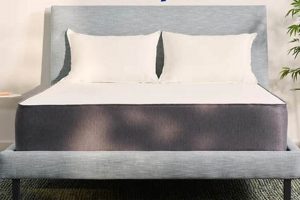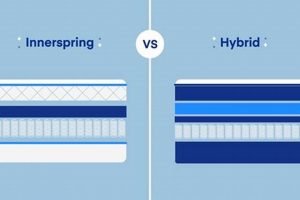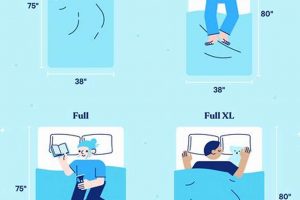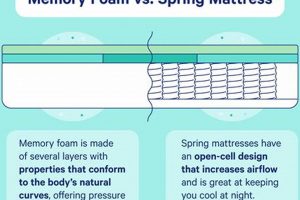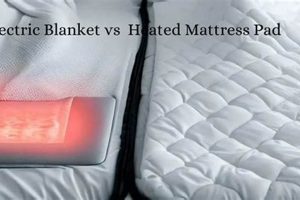The central comparison focuses on two distinct types of spring-based mattress construction. One involves interconnected springs forming a unified support system, while the other utilizes individually wrapped coils that operate independently. These construction methodologies significantly affect motion isolation, contouring, and overall sleeping experience.
The choice between these mattress types can influence sleep quality, spinal alignment, and pressure relief. Historically, the interconnected spring system dominated the mattress market, but advancements in sleep technology led to the rise of individually wrapped coils, offering improved responsiveness and reduced motion transfer. Understanding the characteristics of each design is essential for making an informed purchasing decision.
The subsequent discussion will delve into a detailed comparison of these systems, covering aspects such as support, durability, motion isolation, breathability, and cost, providing a comprehensive overview to aid in selecting the optimal sleep surface.
Selecting a mattress requires careful consideration of individual sleep needs and preferences. Understanding the nuances of different spring systems is paramount to making an informed decision.
Tip 1: Prioritize Support. Assess the level of support each system provides for spinal alignment. A firmer system may be preferable for back sleepers, while side sleepers may benefit from a more contouring system.
Tip 2: Evaluate Motion Isolation. Consider the degree to which motion transfer is minimized. Individually wrapped coils excel at isolating movement, beneficial for couples with different sleep schedules.
Tip 3: Examine Durability. Inquire about the quality of materials and construction techniques. Higher-gauge steel and reinforced edges contribute to long-term durability.
Tip 4: Assess Breathability. Understand how well each system promotes airflow and temperature regulation. Open-coil designs generally offer greater breathability compared to dense foam encasements.
Tip 5: Consider Budget. Establish a realistic budget and compare features within that price range. While individually wrapped coils often command a higher price, options exist at various price points.
Tip 6: Understand Coil Count and Gauge: A higher coil count in a system can indicate more points of support and better contouring. Coil gauge refers to the thickness of the steel wire used in the coils; lower gauges (thicker wires) generally mean firmer support and greater durability.
Tip 7: Research Edge Support: Strong edge support is crucial for maximizing the usable sleep surface of the mattress and preventing sagging along the edges over time. Look for mattresses with reinforced edges, regardless of spring system.
By carefully evaluating these factors, individuals can make a well-informed choice that aligns with their specific needs and preferences, ultimately leading to improved sleep quality and overall well-being.
The following sections will explore additional considerations such as comfort layers and warranty information to provide a more complete picture of the mattress selection process.
1. Support structure
The internal architecture of a mattress, specifically the arrangement and type of its spring system, dictates its level of support. This fundamental aspect directly impacts spinal alignment, pressure distribution, and overall comfort. The distinction in support structure is a primary differentiator in the categorization of innerspring and pocket coil mattresses.
- Interconnected Coil Systems: Uniformity and Stability
In traditional innerspring mattresses, coils are linked together, creating a unified and interconnected support network. This design promotes a consistent level of firmness across the mattress surface. For example, Bonnell coils, a common type of innerspring, are known for their durability and relatively low cost. The implication is a firmer, more stable feel, potentially beneficial for back sleepers but less adaptable to varying body contours.
- Individually Wrapped Coils: Targeted Responsiveness
Pocket coil systems feature individual coils encased in fabric pockets, allowing each coil to move independently. This design facilitates targeted support and responsiveness, contouring to the unique shape of the sleeper’s body. As a result, pressure points are often better alleviated compared to interconnected systems. This is especially beneficial for side sleepers who require more give in the shoulder and hip areas.
- Edge Support Variations: Structural Integrity and Usable Surface Area
Edge support, a crucial component of the support structure, determines the mattress’s stability along its perimeter. Innerspring mattresses often incorporate a border wire or reinforced edge coils to prevent sagging. Pocket coil mattresses may utilize foam encasements or specialized edge coils to achieve similar results. The effectiveness of edge support impacts the usable sleep surface and ease of getting in and out of bed.
- Zoned Support: Tailored Comfort
Advanced mattress designs incorporate zoned support, where different areas of the mattress feature varying levels of firmness. This can be achieved in both innerspring and pocket coil systems. For example, a mattress might have firmer coils in the lumbar region for enhanced back support and softer coils in the shoulder area for increased comfort. Zoned support aims to provide customized comfort and spinal alignment.
The contrasting support structures fundamentally influence the sleeping experience. Innerspring mattresses typically offer a firmer, more uniform feel, while pocket coil mattresses provide more individualized contouring and pressure relief. These differences are critical considerations when selecting a mattress to meet specific sleep preferences and needs.
2. Motion isolation
Motion isolation refers to a mattress’s ability to minimize the transfer of movement across its surface. This is particularly relevant for couples, as it reduces the likelihood of one partner’s movements disturbing the other’s sleep. The degree of motion isolation is a key differentiating factor when evaluating innerspring and pocket coil mattresses.
- Interconnected Coils and Motion Transfer
In traditional innerspring mattresses, the interconnected nature of the coils means that movement in one area is readily transmitted across the entire surface. When one person moves, the connected springs cause a ripple effect, disturbing the sleep of anyone sharing the bed. This can lead to frequent awakenings and disrupted sleep cycles.
- Pocket Coils: Independent Movement
Pocket coil mattresses, with their individually wrapped coils, excel at motion isolation. Each coil reacts independently to pressure, limiting the transfer of movement. This targeted response significantly reduces the ripple effect, allowing one partner to move without greatly affecting the other’s sleep. Therefore, independent movement allows a better quality of sleep.
- Material Density and Vibration Absorption
The density and type of materials used in the comfort layers above the coil system also influence motion isolation. Higher-density foams or memory foam can absorb vibrations and dampen movement. Mattresses that combine pocket coils with dense comfort layers offer superior motion isolation capabilities.
- Coil Gauge and Motion Dampening
While the type of coil system is the primary determinant of motion isolation, the coil gauge (thickness) can also play a role. Thicker coils may transmit more movement than thinner coils, even in a pocket coil system. However, this effect is generally less pronounced than the fundamental difference between interconnected and independent coil systems.
In summary, motion isolation is a crucial aspect of mattress performance, especially for couples. Pocket coil mattresses generally outperform innerspring mattresses in this regard due to their independent coil design, leading to less sleep disturbance and improved sleep quality for both partners. Material density and vibration absorption also play a vital role, improving the comfort of the couple.
3. Contouring ability
Contouring ability, in the context of mattresses, refers to the degree to which a sleep surface conforms to the unique shape of the human body. This adaptability is critical for distributing weight evenly, alleviating pressure points, and promoting spinal alignment. The underlying spring system plays a significant role in determining a mattress’s contouring capabilities. The choice between interconnected innerspring systems and individually wrapped pocket coil systems directly impacts the level of body-conforming support offered. Innerspring mattresses, with their interconnected coils, tend to provide a more uniform and less adaptive surface. For instance, when pressure is applied to one area, the surrounding coils also depress, leading to a less precise fit to the body’s curves. This can result in concentrated pressure on areas such as the shoulders and hips, potentially causing discomfort.
Pocket coil systems, conversely, excel in contouring ability due to the independent movement of each coil. Because each coil is encased in its own fabric pocket, it can compress individually in response to pressure. The result is a sleep surface that more closely conforms to the body’s natural contours, providing targeted support and pressure relief. A real-world example illustrates the benefits: a side sleeper on a pocket coil mattress experiences greater compression in the shoulder and hip areas, allowing for proper spinal alignment and reduced pressure buildup. This advantage is particularly pronounced for individuals with uneven weight distribution or those who prefer sleeping positions that require more localized support. Furthermore, the thickness and composition of the comfort layers above the spring system can enhance or diminish the contouring effect. Thick layers of memory foam or latex, combined with a pocket coil system, can provide exceptional body-hugging comfort.
In summary, contouring ability is a critical factor in mattress performance, impacting comfort, support, and overall sleep quality. Individually wrapped pocket coil systems offer superior contouring compared to interconnected innerspring systems due to their independent coil movement. Understanding this distinction is essential for selecting a mattress that promotes proper spinal alignment and minimizes pressure points, particularly for side sleepers and individuals with specific comfort needs. The practical significance of this understanding lies in the potential to improve sleep quality, reduce pain, and enhance overall well-being through a more personalized and supportive sleep environment.
4. Durability
Durability, as it pertains to mattress construction, reflects the capacity of a mattress to maintain its structural integrity and performance characteristics over an extended period. Assessing durability in the context of innerspring and pocket coil mattresses involves considering factors influencing the lifespan and resistance to degradation of each system.
- Coil Type and Gauge
The gauge (thickness) of the steel wire used in the coils is a primary determinant of durability. Lower gauge numbers indicate thicker, more robust coils that are less prone to bending or breaking under pressure. In innerspring systems, interconnected coils made from higher-gauge steel tend to exhibit greater resistance to sagging. Similarly, pocket coil systems with durable, individually wrapped coils can withstand prolonged use without significant deformation.
- Edge Support Construction
Edge support, whether achieved through reinforced coils, border wires, or foam encasements, is critical for preventing edge collapse. Mattresses with weak edge support are susceptible to sagging along the perimeter, reducing the usable sleep surface and compromising overall stability. Durable edge support construction extends the lifespan of both innerspring and pocket coil mattresses by maintaining their structural integrity.
- Material Quality of Comfort Layers
The quality of materials used in the comfort layers (e.g., foam, padding) significantly impacts overall mattress durability. High-density foams and resilient fibers are more resistant to compression and breakdown over time. Low-quality comfort layers can deteriorate rapidly, leading to body impressions and diminished support. The longevity of both innerspring and pocket coil mattresses is dependent on the quality of these components.
- Construction Techniques and Assembly
The methods used to assemble the mattress influence its long-term durability. Sturdy stitching, secure bonding of layers, and proper reinforcement of stress points contribute to a mattress’s ability to withstand wear and tear. Inadequately constructed mattresses, regardless of coil type, are more likely to develop structural weaknesses and premature failure. Appropriate and quality Construction techniques ensure higher and more longer durability.
In conclusion, assessing the durability of innerspring and pocket coil mattresses requires evaluating coil gauge, edge support construction, material quality of comfort layers, and assembly techniques. While both types of mattresses can be durable, the specific materials and construction methods employed determine their long-term performance. A thorough assessment of these factors is essential for making an informed purchasing decision.
5. Cost considerations
Cost considerations are a significant factor in the evaluation of innerspring mattresses versus pocket coil mattresses. The complexity of manufacturing and the materials used directly influence the pricing of each type, creating a discernible difference in market value. Interconnected innerspring systems, with their simpler design and mass-production efficiencies, typically exhibit a lower price point compared to pocket coil alternatives. This price difference reflects the added labor and specialized machinery required to individually wrap each coil in a pocket coil system.
The implications of this cost disparity extend to consumer purchasing decisions. For budget-conscious consumers, the lower initial investment associated with innerspring mattresses may be a primary deciding factor, particularly when furnishing a guest room or outfitting multiple bedrooms. Conversely, individuals prioritizing motion isolation, targeted support, and enhanced comfort may be willing to allocate a larger budget for a pocket coil mattress. Examining real-world examples, the average queen-size innerspring mattress can range from $200 to $600, whereas a comparable pocket coil mattress may range from $400 to $1200 or more, depending on the brand, materials, and features. This price differential underscores the importance of aligning individual needs and budgetary constraints during the mattress selection process.
In conclusion, cost considerations are an integral component of the innerspring versus pocket coil mattress comparison. The manufacturing processes and materials used directly impact the pricing structure, influencing consumer accessibility and purchasing decisions. While innerspring mattresses offer a more affordable option, pocket coil mattresses provide enhanced features at a higher price point. Understanding these cost implications enables consumers to make informed choices that align with their individual needs and financial resources. The challenge lies in balancing desired features with budgetary limitations to select the optimal mattress for long-term satisfaction.
6. Airflow
Airflow within a mattress is a critical factor influencing temperature regulation and overall sleep comfort. The design of the spring system, whether interconnected innerspring or individually wrapped pocket coils, significantly affects the degree of ventilation and heat dissipation. This aspect is crucial for maintaining a comfortable sleep environment and preventing overheating.
- Open Coil Design and Ventilation
Interconnected innerspring systems typically offer greater airflow due to the open structure between the coils. This unobstructed space allows for air to circulate freely, promoting ventilation and reducing heat buildup. For example, a Bonnell coil innerspring mattress provides ample airflow, particularly when combined with breathable comfort layers. The implication is a cooler sleep experience, especially beneficial for individuals prone to night sweats.
- Pocket Coils and Restricted Airflow
Pocket coil systems, with each coil encased in a fabric pocket, tend to restrict airflow to some extent. The fabric barriers impede the free circulation of air, potentially leading to increased heat retention. However, some pocket coil mattresses incorporate design features to mitigate this issue, such as breathable fabrics and strategically placed ventilation channels. A real-world example shows pocketed coil’s ability to manage the breathability and heat retention.
- Comfort Layer Materials and Breathability
The materials used in the comfort layers above the spring system have a significant impact on overall breathability. Open-cell foams, natural latex, and moisture-wicking fabrics enhance airflow and reduce heat retention. Conversely, dense memory foam can restrict airflow, potentially exacerbating heat buildup. The selection of breathable comfort layer materials is crucial for optimizing temperature regulation, regardless of the spring system.
- Mattress Height and Ventilation
The overall height of the mattress can also influence airflow. Thicker mattresses, particularly those with multiple layers of dense materials, may restrict ventilation. Mattresses with thinner profiles or those incorporating breathable spacer fabrics may promote better airflow. Therefore, thickness and breathability can work to affect the airflow with both design. The combination of these elements determines the overall effectiveness of temperature regulation.
In conclusion, airflow is an important consideration in the innerspring versus pocket coil mattress comparison. While innerspring systems generally offer superior ventilation due to their open coil design, pocket coil mattresses can be engineered to improve airflow through breathable materials and strategic design features. The choice between the two depends on individual temperature preferences and the overall construction of the mattress, with careful attention paid to the breathability of the comfort layers.
7. Noise reduction
The issue of noise reduction in mattresses is a pertinent factor contributing to sleep quality and overall user satisfaction. Differentiating between innerspring and pocket coil systems reveals key insights into their respective noise generation potential, impacting the sleep environment.
- Coil Friction and Squeaking
Interconnected innerspring systems are prone to noise generation due to coil-to-coil friction. As the sleeper moves, the interconnected springs rub against each other, producing squeaking or creaking sounds. The magnitude of this noise depends on the coil gauge, the presence of lubrication, and the age of the mattress. Over time, wear and tear can exacerbate coil friction, leading to increased noise levels. This noise disturbance directly affects sleep quality, potentially causing awakenings and reduced restfulness. This issue of noise is not a thing with pocket coils.
- Independent Coil Movement and Sound Dampening
Pocket coil systems exhibit superior noise reduction properties due to the independent movement of each coil. Encasing each coil in a fabric pocket minimizes friction between coils, significantly reducing the potential for squeaking or creaking sounds. The fabric pockets act as sound dampeners, absorbing vibrations and preventing noise transmission. This quiet operation is a key advantage of pocket coil mattresses, promoting a more peaceful sleep environment.
- Material Composition and Vibration Absorption
The type and density of materials used in the comfort layers also contribute to noise reduction. High-density foams and latex layers can absorb vibrations and dampen sound transmission. Mattresses with thicker comfort layers tend to be quieter than those with thinner layers. Combining pocket coils with sound-absorbing comfort layers further enhances noise reduction, creating a sleep surface that minimizes disturbances.
- Frame Compatibility and Noise Amplification
The compatibility of the mattress with the bed frame is an often-overlooked factor influencing noise levels. An improperly supported mattress can amplify noise generated by the spring system. Using a sturdy and well-maintained bed frame that provides adequate support is crucial for minimizing noise transmission. Furthermore, placing the mattress directly on the floor can dampen vibrations and reduce noise, but may compromise airflow.
In summary, noise reduction is a significant differentiator between innerspring and pocket coil mattresses. The interconnected nature of innerspring systems makes them more susceptible to noise generation, while the independent coil movement and sound-dampening properties of pocket coil systems promote a quieter sleep environment. Considering these factors is essential for selecting a mattress that minimizes disturbances and enhances sleep quality. The choice must be balanced with the customer’s budget in mind.
Frequently Asked Questions
This section addresses common inquiries and clarifies potential misconceptions surrounding the comparison between innerspring and pocket coil mattress systems.
Question 1: What is the fundamental difference between an innerspring mattress and a pocket coil mattress?
The primary distinction lies in the coil construction. Innerspring mattresses utilize interconnected coils, creating a unified support structure, whereas pocket coil mattresses feature individually wrapped coils, allowing for independent movement and targeted support.
Question 2: Does a higher coil count always indicate a better mattress?
While coil count can be an indicator of potential support and contouring, it is not the sole determinant of mattress quality. The coil gauge, material quality, and overall construction also contribute significantly to the mattress’s performance and longevity.
Question 3: Are pocket coil mattresses inherently more durable than innerspring mattresses?
Not necessarily. Durability depends on a variety of factors, including the coil gauge, edge support construction, and the quality of the comfort layers. Both innerspring and pocket coil mattresses can be durable, provided they are constructed with high-quality materials and sound engineering principles.
Question 4: Which type of mattress is better for motion isolation?
Pocket coil mattresses generally provide superior motion isolation compared to innerspring mattresses. The independent movement of the individually wrapped coils minimizes motion transfer, reducing the likelihood of disturbing a sleeping partner.
Question 5: Are innerspring mattresses always more affordable than pocket coil mattresses?
Yes, innerspring mattresses tend to be more affordable due to their simpler construction and mass-production efficiencies. However, price variations exist within each category depending on the brand, materials, and features.
Question 6: Which type of mattress is better for back pain?
The optimal choice for back pain depends on individual preferences and spinal alignment needs. Innerspring mattresses can provide firm, uniform support, while pocket coil mattresses offer targeted support and pressure relief. Consulting with a healthcare professional is recommended to determine the most suitable mattress for specific back pain conditions.
In summary, the selection between innerspring and pocket coil mattresses involves a nuanced consideration of various factors. The intended use cases play a critical role in this decision. Understanding the nuances of each coil system and aligning that knowledge with individual needs forms the foundation for informed decision-making.
The next section explores alternative mattress technologies beyond innerspring and pocket coil systems.
Concluding Assessment
The preceding analysis has dissected the core attributes of innerspring mattress and pocket coil mattress designs, focusing on support, motion isolation, durability, and cost. Each system presents distinct advantages: interconnected innersprings offer affordability and uniform support, while individually wrapped pocket coils excel in targeted contouring and motion isolation. These variances directly impact sleep quality, spinal alignment, and overall user satisfaction.
Ultimately, the optimal choice necessitates a careful evaluation of individual needs and preferences. Armed with a comprehensive understanding of these contrasting technologies, consumers can make informed decisions to enhance their sleep environment and long-term well-being. Further research into comfort layers, materials, and warranty provisions is encouraged to refine the selection process. The continuous evolution of sleep technology promises further advancements in mattress design, warranting ongoing exploration and critical assessment of available options.


